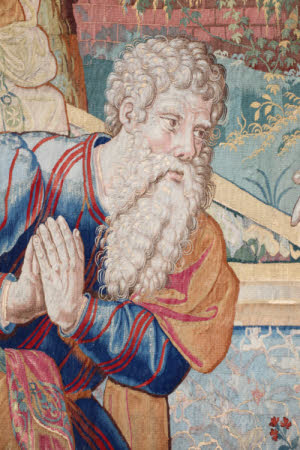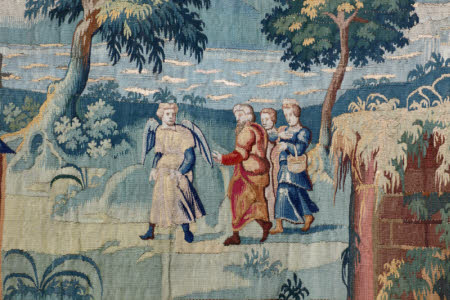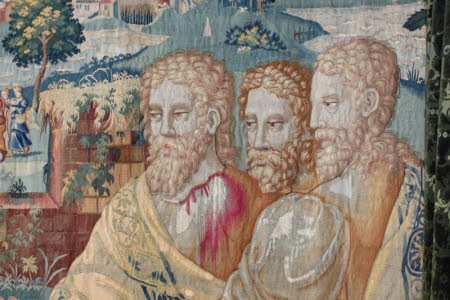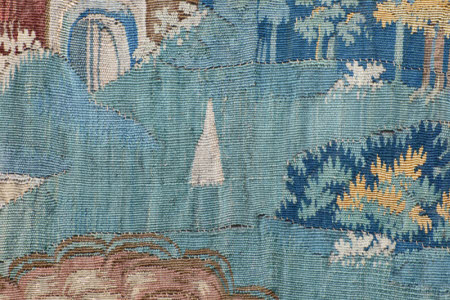God Appears to Abraham
probably Oudenaarde
Category
Tapestries
Date
circa 1580 - circa 1590
Materials
Tapestry, wool and silk, 6-7 warps per cm
Measurements
3.5 m (H); 3.7 m (W)
Place of origin
Oudenaarde
Order this imageCollection
Hardwick Hall, Derbyshire
NT 1129441.1
Summary
Tapestry, wool and silk, 6-7 warps per cm, God Appears to Abraham from a set of four of the Story of Abraham, probably Oudenaarde, c. 1580-1590. In the centre Abraham kneels, his hands clasped, before God who appears to him in the form of three men who stand looking down at him. On the left in the background Abraham watches while the three men eat a meal at a table under a tree, and his wife Sarah watches from the doorway of a classical building. In the distance behind the central figures is a small group of three figures being led by an angel, and on the horizon a city in flames. The borders of the tapestry are composed of decorative architectural forms amongst foliage and fruit, with allegorical figures at the corners.
Full description
'God Appears to Abraham' is the third tapestry in the 'Story of Abraham' set at Hardwick, and the fifth in the series as a whole. God appeared to Abraham in the field of Mamre as he sat at his tent door in the heat of the day. Abraham looked up and saw God in the form of three men standing by him, and ran out to bow down to them. This is the main scene in the tapestry. Abraham then begged the Lord to stay and eat, and he asked Sarah to make bread while he went and fetched a tender calf, and butter and milk. He set the meal before the three men under a tree, and they ate. The Lord then told Abraham that his wife Sarah, who had so far had no offspring, would bear a child. Abraham and Sarah were old and Sarah was past childbearing age, and she laughed when she heard this; the Lord asked why she had laughed, as nothing is too hard for the Lord. This is the scene on the left hand side of the tapestry, with Abraham standing by as the three men eat, and Sarah in the doorway of the house (not a tent as in the biblical account) talking to them. (Genesis 18, 1-15). The men then rose to leave, and the Lord said that he would go to Sodom and Gomorrah and bring justice upon them for their sins. Before the destruction of Sodom and Gomorrah two angels went to Sodom and spoke to Lot, Abraham's nephew. He asked them to come into his house and eat, and the people of the town tried to attack them but were struck blind. The angels told Lot to take his family and flee Sodom because they had been sent to destroy the city (Genesis 19, 1-26). The three small figures being led by an angel in the background of the tapestry represent Lot and his daughters heading for the mountains. Lot's wife had been turned into a pillar of salt because she ignored the angels' instructions not to look back when leaving Sodom. She may be the small whitish pillar near the gates of the city. The four 'Story of Abraham' tapestries are based on a series of designs first woven in Brussels in around 1540. The earliest known set was bought by Henry VIII in 1543-4 and survives at Hampton Court Palace, and further sets were woven in the sixteenth century for other patrons. The tapestries at Hardwick belong to a second generation of 'Abraham' tapestries, woven in the late sixteenth century from modified copies of the original cartoons. The original 'Abraham' series comprised ten scenes illustrating the major events in Abraham's life, and emphasising his role as the progenitor of the Hebrew nation, his covenant with God and its continuation through his son Isaac. The ten subjects are 'God Commands Abraham to Lead the Israelites into Canaan', 'The Return of Sarah by the Egyptians', 'The Parting of Abraham and Lot', 'The Meeting of Abraham and Melchisedek', 'God Appears to Abraham', 'The Circumcision of Isaac', 'The Sacrifice of Isaac', 'Abraham Purchases the Field of Ephron', 'The Oath and Departure of Eliezer' and 'Rebecca at the Well'. Thomas Campbell has argued that the 'Abraham' set woven for Henry VIII was the first set ever woven, and that Henry may have commissioned the designs himself. The subject of Abraham was part of a personal iconography which aligned Henry with Old Testament patriarchs as a means of justifying his new position as head of the Church of England. Abraham also figured in Christian typology as the progenitor of Christ, and would therefore have had additional resonance following the birth of Henry's son Edward in 1537. Henry's 'Abraham' tapestries were among the richest in his collection and may well have been known to the Countess of Shrewsbury ('Bess of Hardwick') when she purchased her own version of the designs at the end of the sixteenth century. The designer of the 'Abraham' series is unknown. The series has been attributed to Bernard van Orley (c. 1488-1541), and more recently to either Michiel Coxcie (1499-1592) or Pieter Coecke van Aelst (1502-1550), both of whom designed large-scale narrative tapestries for the Brussels industry in the mid sixteenth century. Examining the available evidence Thomas Campbell has suggested that the designs were in fact a collaboration, with the initial idea being supplied by van Orley and the finished designs being completed after his death in 1541 by his pupil Pieter Coecke van Aelst (Campbell 2003, pp, 63-4). The cartoons from which Henry VIII's 'Abraham' tapestries were woven were re-used more than once in Brussels in the mid sixteenth century. The tapestries at Hardwick however depart from the original designs in a number of ways, and were almost certainly woven using copies of the original cartoons. The figures, though following the same basic outlines, are disposed differently, mainly to fit each scene into a smaller area. In addition the exhaustive detail of the original series has been simplified, and foliage appears in many areas that were originally filled with beautifully described architectural detail. The colours have also been modified substantially, with bright pinkish red and orange tones now dominating. The borders on the Hardwick tapestries are far simpler than those found on the early weavings of the 'Abraham' series. They are relatively narrow and composed of decorative strap-work and architectural forms amongst foliage and fruit. At the corners there are allegorical female figures representing Faith, with a cross and a book, Justice, blindfold and holding a sword and scales, Fame blowing a trumpet (on 'The Return of Sarah by the Egyptians'), and women playing lutes. These figures seem to echo the extensive array of allegorical figures that appear on Henry VIII's 'Abraham' tapestries, although only one of them, 'Faith', replicates a subject found on the early sets. In the centre of the upper and lower borders is a small scene with a goat kicking over a bowl of its own milk, in one case accompanied by the inscription 'IN LE SCISCENTES'. On 'The return of Sarah by the Egyptians' the goat is replaced in the upper border by a dragon attacking a griffin. There are small figures of fauns playing pipes in the horizontal borders, and peacocks in the side borders. The tapestries were purchased in 1591, and their price, 20s. per ell for 'The Return of Sarah' which includes gold thread, and 14s. per ell for the others (see below), suggests that they were either new or nearly new. Comparison with a ten-piece 'Abraham' set now in the Residenz, Munich and apparently from the same cartoons as the set at Hardwick, also suggests a late sixteenth century date. The Munich set was recorded in the collection of Ottheinrich in 1584 and has been dated to c. 1570 by Campbell, who suggests that this is the 'edition princeps' of the second generation of Abraham tapestries. The set at Hardwick can therefore be dated to c. 1580-1590. One of the tapestries at Hardwick, 'God Appears to Abraham' (1129441.1), bears an unusual maker's mark in the form of two 'S's facing one another and joined by two crossbars, possibly representing a lyre, or a stylised letter 'M'; below this is another smaller mark in the form of a hooked line. Neither matches any know signature, and there is no mark indicating the city in which the tapestries were made. The two marks are woven in light blue against the dark blue galloon, and their style is distinct from the monograms usually used by Brussels workshops in the sixteenth century. It is possible that instead the tapestries were woven at Oudenaarde, especially as the merchant who sold them to Bess of Hardwick seems to have had connections with that city (see below). Although the four tapestries are similar in dimensions and overall construction, they are not a unified set. Most obviously one of the tapestries, 'The Return of Sarah by the Egyptians', is woven with gilt-metal thread for the highlights (now tarnished to dark brown), whereas the other three contain no metal thread. This was reflected in the price when the tapestries were purchased. There are also noticeable differences between the borders on the four tapestries, although they share the same basic structure and elements. For two of the tapestries the lower border has been woven separately and then stitched on, possibly a sign of cheap and rapid production. Numerous reweavings survive of the 'Abraham' series, most dating from the mid sixteenth century and made in Brussels from the original cartoons. These include a set bought by the English crown in 1661 for the coronation of Charles II, which now hang in the Jerusalem Chamber at Westminster Abbey (Campbell 2003, p. 81). The 'second generation', to which the series at Hardwick belongs, is represented by the set in the Munich Residenz, mentioned above (illustrated in Roethlisberger 1971). In the mid seventeenth century the designs were revived yet again, at the Mortlake workshop on the banks of the Thames outside London. The Mortlake 'Abraham' tapestries were based on the tapestries in the English Royal collection bought by Henry VIII, but with new scenes and borders designed by Francis Cleyn. The most complete set of Mortlake 'Abraham' tapestries is in the National Trust's collection at Blickling Hall, Norfolk (355716). The Hardwick 'Abraham' tapestries were bought by Bess of Hardwick during a trip to London in 1591, in four instalments. On 19 March 1591 she paid a certain "Wm. de Mulmaster" £38.15s for "a peece of cloth of Arras wth gould of the Story of Abraham contayninge xxxviii flemishe Els iii qtrs [38 ¾ Flemish Ells]", at a price of 20 s. per Ell. This must have been 'The Return of Sarah by the Egyptians', the only tapestry in the set to contain gold thread. Later the same week Bess paid £24.10s. for "an other peece of Arras of the Storye of Abraham" measuring 35 Flemish Ells at 14 s. the Ell, the lower price reflecting the lack of gold thread. On 20 April 1591 she bought a third Abraham tapestry from Mulmaster for £21, this one measuring 30 Flemish Ells, at the same price of 14 s. per Ell. Finally on 10 July 1591 Bess purchased a fourth and final Abraham tapestry for £28, this one measuring 40 Ells, and again at 14 s. per Ell (Chatsworth Archive, Hardwick MS7, ff. 18r, 21v, 28v). The 'Wm de Mulmaster' who sold the tapestries to Bess may have been Willem de Mulmaster, a native of Oudenaarde whose name is mentioned in the register of the Dutch Church in London in 1588, one of the many Flemish protestants who fled to England late sixteenth century. He may have been related to the Gillis de Meulemeester who was a tapestry worker in Bevere, a province of Oudenaarde, in 1552 (Vanwelden 2006, pp. 138, 172). The 1601 inventory of Hardwick Hall lists the Abraham tapestries in the Withdrawing Chamber: "An other sute of hanginges for the same roome being fowre peeces or Arras of the storie of Abraham, everie peece twelve foote deep." (Levey and Thornton 2001, p. 47). The Withdrawing Chamber is next door to the Green Velvet Bedroom (the former Best Bedroom, and part of the same suite of state apartments), where the tapestries hang today. In 1601 the Withdrawing Chamber was a double-height room like the neighbouring High Great Chamber and Long Gallery. The tapestries seem to have been an alternative to the main hangings for the room, a series of embroidered panels of 'Virtues', which hung here and in the neighbouring Best Bedchamber (the 'Virtues' are today set into screens in the Hall; no. 1129593). Santina Levey has speculated that although the 'Abraham' tapestries were provided as alternative hanging, in fact the 'Virtues' in the Withdrawing Room were never moved (Levey 1998, p. 35), and the exceptionally bright surviving colours of the 'Abraham' series may be a result of their never having been on permanent display. Horace Walpole visited Hardwick in 1760 and described the hangings of the State Withdrawing Room (which he called a dressing room) as 'patchwork on black velvet', and went on to describe the 'Virtues' in the neighbouring State Bedchamber in some detail, suggesting that the 'Abraham' tapestries were not on display at this time (Toynbee 1903-5, vol. 4, p. 424). The 6th Duke of Devonshire's 1844 'Handbook to Hardwick and Chatsworth' makes no mention of the 'Abraham' tapestries, and they were not in either the Green Velvet Bedroom or the Withdrawing Room at that date. Evelyn, Duchess of Devonshire mentions the 'Abraham' set in two sets of 'Notes' on Hardwick written in 1945 and 1946, saying that she moved them from her own room (Bess's Bedroom) to their current position in the Green Velvet Bedroom, and that she installed a curtain on a rail to protect the tapestry on the south wall of the room from the evening sun (Devonshire 1945; Devonshire 1946). The tapestries were installed by 1928, when they appear in Country Life photographs. (Helen Wyld, 2011)
Provenance
Bought by Elizabeth, Countess of Shrewsbury from William Mulmaster in 1591; thence by descent to Andrew, 11th Duke of Devonshire; acquired through the National Land Fund in 1956 and transferred to the National Trust in 1959.
Credit line
Hardwick Hall, The Devonshire Collection (acquired through the National Land Fund and transferred to The National Trust in 1959)
Makers and roles
probably Oudenaarde, workshop attributed to Pieter Coecke van Aelst, the Elder (Aalst 1502 - Brussels 1550), designer attributed to Bernaert van Orley (Brussels c.1488 - Brussels c.1541), designer
References
Vanwelden, 2006: Martine Vanwelden, Productie van wandtapijten in de regio Oudenaarde: een symbiose tussen stad en platteland (15de tot 17de eeuw), Leuven 2006 Campbell, 2007a: Thomas Campbell et al., Tapestry in the Baroque: Threads of Splendor, exh. cat. Metropolitan Museum of Art, New York 2007 Campbell, 2007b: Thomas Campbell, Henry VIII and the Art of Majesty: Tapestries at the Tudor Court, New Haven & London 2007 Campbell, 2003: Thomas Campbell, 'The Story of Abraham tapestries at Hampton Court Palace', in Koenraad Brosens (ed.), Flemish Tapestry in European and American Collections: Studies in Honour of Guy Delmarcel, Turnhout 2003, pp. 59-85 Campbell, 2002: Thomas Campbell (ed.), Tapestry in the Renaissance: Art and Magnificence, exh. cat. Metropolitan Museum of Art, New York 2002 Levey and Thornton 2001: Santina Levey and Peter Thornton, Of Houshold Stuff: The 1601 Inventories of Bess of Hardwick, London, The National Trust, 2001 Roethilsberger, 1971: Marcel Roethlisberger, 'Deux tentures bruxelloises du milieu du XVIe siècle', Oud Holland, vol. 86 (1971), pp. 88-115 Devonshire, 1945: Evelyn, Duchess of Devonshire, Notes on the 6th Duke’s Handbook, written for her daughter-in-law Mary Cecil, 1945 (Unpublished manuscript, Hardwick Hall) Devonshire, 1946: Evelyn, Duchess of Devonshire, Notes on Hardwick following the route of the 1601 inventory, 1946 (Unpublished manuscript, Hardwick Hall) Toynbee, 1903-5: Paget Toynbee (ed.), The Letters of Horace Walpole, 16 vols., Oxford 1903-5 Devonshire, 1844: William George Spencer Cavendish, 6th Duke of Devonshire, Handbook of Hardwick and Chatsworth, London, 1844





